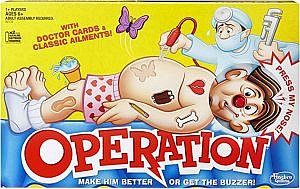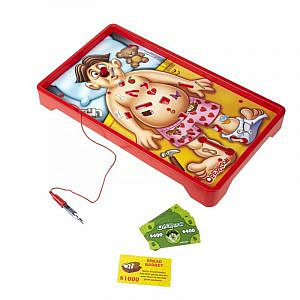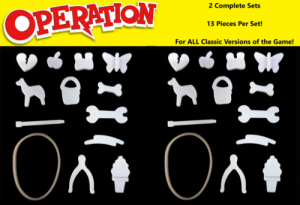
“Operation” is a game that was released in 1965 by Marvin Glass and John Spinello for the Milton Bradley Company. Distributed by Hasbro and rated for ages 6+, this game that went around the world in the 1970s requires sharp dexterity for fruitful development.
Thus, the game begins with the preparation of the board. The board itself is a metal plate that simulates an operating table in an operating room. The patient is lying on his back and on his body there are a series of holes from which bones and other plastic objects must be extracted, many of them they unusual. Extraction is performed with special metal tweezers. Each piece must be removed very carefully and skilfully by the players, without touching the sides.
Otherwise, a buzzer is activated and the patient’s nose lights up, and the player has lost. The objective of Operation is to earn as much money as possible for each successful operation, until you complete all of them. They can play from one to four players and there is a person in charge of distributing the money. In the game there are two stacks of cards, “Doctor” and “Specialist”.
The “Doctor” cards specify the piece to be removed and the money that will be won if it is done correctly. If it goes wrong, everyone should look to see if they have a “Specialist” card whose description matches the failed operation. If so, whoever owns it will make the extraction to try to earn double.

This is a quite simple dynamic to understand but that without a doubt creates a state of tension and constant alert among all the players. In my different games I could feel how, me and my friends, our pulse trembled too much in each of the attempts to remove a piece. We were quite nervous, because touching the sides is very easy and you feel the pressure of wanting to do well to win. Seeing the faces and the nerves of my friends was undoubtedly the most fun. It was not when it was my turn.
Without a doubt, it is a game that, in general terms, I have enjoyed with pleasure since the game developed quickly and lightly. However, I must comment that it is quite difficult not to touch the sides, and that many times I saw it as almost impossible for someone to do it well. Many of the gaps are too small and the alarm is very sensitive. Although this is the only negative thing I can say about it, I think this is what makes the game so entertaining. Without this difficulty the game would not make sense.
Likewise, I would like to comment on the classic design that the game has and that has always been respected over the years. It is not the best illustration you can find, but it is certainly very faithful to its origin and it is also very funny and comical. Each one of the pieces that you have to extract are disparate and I think that makes it even more fun.


Without a doubt, it is a game that I have enjoyed playing in company and that I consider to have a very good development and objective. It’s the kind of game you want to play when you want to have a laugh with your friends on a rainy afternoon. For this reason, I highly recommend it to anyone who wants to have a good time, but yes, only to those who have controlled tension, because the game will make you shoot it.
-Basic info: Designers: Marvin Glass and John Spinello | Publisher: Hasbro | Release date: 1965 | Number of players: 1-4 players | Playing time: 10-15 minutes | Ages: +6
-Pictures source: promo pictures from the official website of the board game https://shop.hasbro.com/es-es/product/classic-operation-game/03B9FF5E-5056-9047-F5FF-D57592C4E2FE
